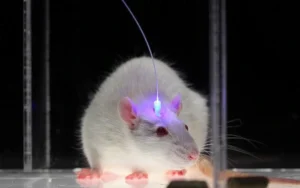Dr. Pablo Barrecheguren explains what optogenetics is, its preclinical results, and the technical and moral challenges of this technique.
Of all the techniques developed in neuroscience in recent years, optogenetics is surely the one that has most rapidly become normalized as a working tool in laboratories.
Its use is such that striking preclinical results are already beginning to be obtained. For example, as of today its use is being evaluated as a therapy in the treatment of neurological-based vision problems and, continuing with the senses, systems have already been developed in rodents that allow partial recovery of hearing using this type of technology as a possible alternative option to current cochlear implants. Although preclinical and modest, these are great results considering the relative youth of this technique, but… exactly what is optogenetics?
What exactly is optogenetics
Optogenetics is based on the use of light-sensitive ion channels and pumps (opsins) for the activation or inhibition of neurons, which allows manipulation of neuronal activity in vivo. That said, it should be taken into account that the presence of opsins is achieved through genetic engineering, and two different variants can be applied:
- Injection of viral vectors into adult organisms. In this case viral particles carrying the opsins are produced, the viruses are injected directly into the area of the brain where we want to apply optogenetics, the viruses infect the neurons and those neurons begin to produce opsins;
- direct creation of genetically modified animals that express opsins in certain areas of the brain or injection of viral vectors in utero into the brains of model organisms.
Research
Depending on the field of research, one strategy or another is used in a model organism, which are generally mice. But either way, the result is that we have a living being with opsins in its neurons. As a consequence of this, if those neurons are stimulated with light, the opsins will respond to it, generating activation or inhibition of the neurons depending on the modifications we have made. And since it is possible to be fairly specific when choosing which neurons express opsin and which do not, the result is that we can regulate at will the activity of specific neural pathways.
This is key to identifying the function of each neuronal network. For example, if we suspect that activation of certain neurons increases appetite, we can create a mouse that has opsins in those neurons, stimulate those cells with light and see whether the mouse consumes more calories. Moreover, literally the system works like a switch, so we can turn those neurons off or on whenever we want while we observe how, or whether, the animal’s behavior changes in real time.
This has made optogenetics the most powerful tool for behavioral studies, but its potential also lies in the study of brain development, since we can induce changes in neuronal activity and then analyze whether that alters the development of the nervous system.
Challenges of optogenetics
Even so, it is always important to remember that this is still basic biomedical research, which must overcome many challenges before it can be used clinically. These are two of the main obstacles:
- Normally, cells are stimulated with light by implanting an intracranial device. This, although surgically possible, is a factor to be seriously considered if we are talking about potential use in humans.
- For the technique to work it is necessary to genetically manipulate the organism. Today it is already possible to create transgenic non-human primates, although they are extremely rare and their use is much more complex than that of other model organisms. But even when technical problems are solved, this will not eliminate the ethical conflict of having to use genetic engineering in humans to be able to apply optogenetics biomedically.
It is clear that the challenges, both technical and moral, posed by optogenetics are commensurate with its great potential in the field of neuroscience, so it is a technique that should be followed with particular interest over the coming years.
References
- Deubner, J., Coulon, P., & Diester, I. (2019). Optogenetic approaches to study the mammalian brain. Current Opinion in Structural Biology, 57(1), 157–163.
- Galvan, A., Stauffer, W. R., Acker, L., El-Shamayleh, Y., Inoue, K., Ohayon, S., & Schmid, M. C. (2017). Nonhuman Primate Optogenetics: Recent Advances and Future Directions. The Journal of Neuroscience, 37(45), 10894–10903.
- Keppeler, D., Vogl, C., Dieter, A., Moser, T., Huet, A., Jeschke, M., … Duque-Afonso, C. J. (2018). Optogenetic stimulation of cochlear neurons activates the auditory pathway and restores auditory-driven behavior in deaf adult gerbils. Science Translational Medicine, 10(449), eaao0540.
- Roska, B., & Sahel, J.-A. (2018). Restoring vision. Nature, 557, 359-367.
If you liked the article on optogenetics by Dr. Pablo Barrecheguren, you may also be interested in other articles he has published:
“This article has been translated. Link to the original article in Spanish:”
¿Qué es la optogenética?







 Behavior Reeducation Through Cognitive Training
Behavior Reeducation Through Cognitive Training
Leave a Reply